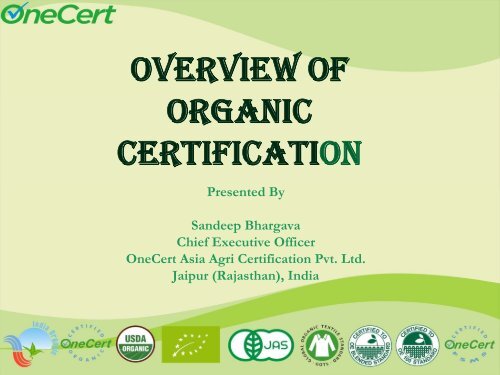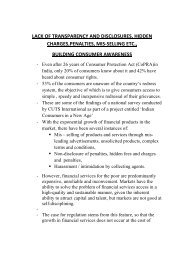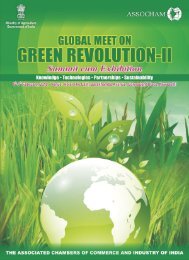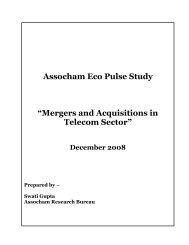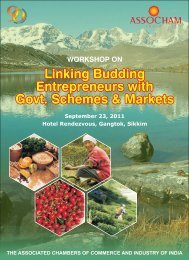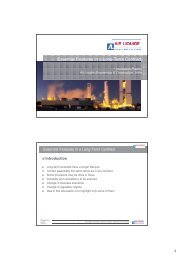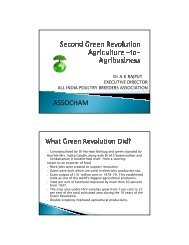Overview of Organic Certification
Overview of Organic Certification
Overview of Organic Certification
You also want an ePaper? Increase the reach of your titles
YUMPU automatically turns print PDFs into web optimized ePapers that Google loves.
HISTORY OF ORGANICCERTIFICATIONNo <strong>Certification</strong> &Standard RequiredHey!<strong>Organic</strong>Corn<strong>Organic</strong> Products Salethrough Trust &Personal Relationship
HISTORY OF ORGANICCERTIFICATION<strong>Organic</strong>ProductsSalethroughTrustHey!<strong>Organic</strong>CornSold TheirconventionalProducts byclaiming them<strong>Organic</strong>
HISTORY OF ORGANICCERTIFICATIONWhatThingsInclude InStandardPhase 1 Phase 2What isProhibitedDevelop Private StandardProducer & Consumers sit together anddeveloped <strong>Organic</strong> Standards.Soil Association, Great Britain was found in 1946and developed <strong>Organic</strong> Standards
Regulatory Environment<strong>Organic</strong> certification and standard setting developed out<strong>of</strong> the organic movement as private sectors initiatives,from the bottom and up.It is based on voluntary participation <strong>of</strong> producers and/orhandlers/processors.As the organic market grew, it became a public-privatepartnership with governments setting legal definitions <strong>of</strong>‘organic’ and setting enforcement mechanisms.
Regulatory Environment EU regulation sets minimum standards, allowing differentgovernments and certification/inspection bodies to certify tostandards that meet or exceed the EU regulation-1992. In the USA, the <strong>Organic</strong> Food Production Act (OFPA) wasimplemented by the National <strong>Organic</strong> Program (NOP)-2000. India notified its own standards for exports under NationalProgram for <strong>Organic</strong> Production (NPOP) in 2003.Amended in2005 and are EEC regulation, Swiss ordinance and Conformityassessment is recognized by USDA-NOP
INTERNATIONAL ORGANICSTANDARDSNational Programme for <strong>Organic</strong> Production (NPOP)National <strong>Organic</strong> Program (NOP)European Economic Commission (EEC) 834/2007Japan Agricultural Standards (JAS)International Federation for <strong>Organic</strong> Agriculture Movements
WHY CERTIFICATION IS NEEDEDBuilding Trust Between Consumer and <strong>Organic</strong> ProducerRecognize trust worthy organic products easily
WHY CERTIFICATION IS NEEDEDThese AreCertified <strong>Organic</strong>VegetablesYeh!Certified<strong>Organic</strong>Important marketing toolAchieve better price as compared to conventional products
NEED OF ORGANICCERTIFICATION<strong>Certification</strong> is link between farmer, processorand consumer.Demand <strong>of</strong> Certified <strong>Organic</strong> Products in World WideNPK<strong>Organic</strong> Products Meet Stringent Standards
NEED OF ORGANICCERTIFICATIONConsumer Are Health ConsciousSmall & Marginal Farmers are not getting properPrice <strong>of</strong> their produce
BENEFITS OF ORGANICCERTIFICATION<strong>Organic</strong> certification build trust between consumer andorganic farmers.<strong>Organic</strong> labels and certification marks help the consumer toidentify the organic products easily.Conventional<strong>Organic</strong>Better price compared to conventional products.
BENEFITS OF ORGANICCERTIFICATIONConnect small farmers to global market.Small Farmers can bargain and get premium price onCertified <strong>Organic</strong> Products, like cumin, Basmati Rice etcTransaction certificate send along withorganic produce verify the Country <strong>of</strong>Origin.Transaction certificate ensures traceability.
CRITERIA FOR SELECTION OF CERTIFICATIONAGENCYSelecting the CB: Operator (producer or processor) requests information. Selecting CB depends on: market, cost, standards, reputation,service & recognition. Operator should read and understand standards to determineif they qualify for certification. It is an annual process. Accreditation/acceptability in the importing country.Cont…
CRITERIA FOR SELECTION OFCERTIFICATION AGENCY Acceptability <strong>of</strong> Certificate. Comply with the standards <strong>of</strong> the importing country. Services and support provided by certification agency. <strong>Certification</strong> Procedure. Terms and conditions. Affordability. Acceptability and recognition <strong>of</strong> logo. Costing. Status.
REQUIREMENTS FOR ORGANIC CROPCERTIFICATION Comply with the act and applicable organic production andhandling regulation.1. No use <strong>of</strong> prohibited materials for three years/36 Months2. Maintain the records or provide the evidence that operatorhad not used any prohibited material from last 36 Months.3. Notify the certifier about start <strong>of</strong> conversion (NPOP andEEC 834/2007).Cont…
REQUIREMENTS FOR ORGANIC CROPCERTIFICATION• Establish, implement, and update annuallyan organic production or handling systemplan that is submitted to certification body(NOP Requirement).• Maintain the required Records and keep for5 years• Permit on-site inspections with completeaccess to all facilities.
REQUIREMENTS FOR ORGANIC CROPCERTIFICATIONImmediately notify the certifying body concerning any: Application, including drift, <strong>of</strong> a prohibited substance toany field, production unit, site, facility, livestock, orproduct that is part <strong>of</strong> an operation; and Change in a certified operation or any portion <strong>of</strong> acertified operation that may affect its compliance with theAct and the regulations in this part.
REQUIREMENTS PROCESSING &HANDLING CERTIFICATION <strong>Organic</strong> products should not co-mingle with non-organicproducts. All organic products shall be clearly identified as such, andstored and transported in a way that prevents contact withconventional product through the entire process. Take all necessary measures to prevent organic productsfrom being contaminated by pollutants and contaminants,including the cleaning, decontamination, or if necessarydisinfections <strong>of</strong> facilities and equipment.
INGREDIENT <strong>Organic</strong> processed products are only made from organicingredients . Water and salt may be used as ingredients in the production<strong>of</strong> organic products and are not included in the percentagecalculations <strong>of</strong> organic ingredients.Processing <strong>Organic</strong> food is processed by biological, mechanical andphysical methods in a way that maintains the vital quality <strong>of</strong>each ingredient and the finished product.
PROCESSING METHODS Extraction shall only take place with water, ethanol, plant andanimal oils, vinegar, carbon dioxide, nitrogen. These shall be<strong>of</strong> a quality appropriate for their purpose. Irradiation is not permitted.
PEST & DISEASE CONTROL <strong>Organic</strong> food is protected from pests and diseases by the use<strong>of</strong> good manufacturing practices that include proper cleaning,sanitation and hygiene, without the use <strong>of</strong> chemical treatmentor irradiation.CLEANING, DISINFECTING, ANDSANITIZING <strong>Organic</strong> food is safe, <strong>of</strong> high quality, and free <strong>of</strong> substancesused to clean, disinfect, and sanitize food processing facilities. Educate personnel in hygiene, sanitation, safe food handling,and organic standards.
PACKAGING <strong>Organic</strong> product packaging has minimal adverse impacts onthe product or on the environment. <strong>Organic</strong> food should be packaged in reusable, recycled,recyclable, and biodegradable packaging whenever possible. Packaging materials, and storage containers, or bins thatcontain a synthetic fungicide, preservative, or fumigant areprohibited. <strong>Organic</strong> produce shall not be packaged in reused bags orcontainers that have been in contact with any substance likelyto compromise the organic integrity <strong>of</strong> product or ingredientplaced in those containers.
<strong>Organic</strong><strong>Certification</strong>Process
ORGANIC CERTIFICATIONPROCEDURE Telephone Applicant visit OneCert <strong>of</strong>fice Through extn. Worker E-mail Written requestApplicants CallEntry into EnquiryRegister
ORGANIC CERTIFICATIONPROCEDUREDispatch <strong>of</strong> Application PacketIts Contain :Application for <strong>Certification</strong><strong>Certification</strong> AgreementFees Schedule<strong>Organic</strong> System Plan - Crop/<strong>Organic</strong> System Plan –Handler-Processor/<strong>Organic</strong> System Plan - LivestockField History FormFarm Products and Inventory List<strong>Organic</strong> Product Pr<strong>of</strong>ile
ORGANIC CERTIFICATIONPROCEDUREReceived complete/duly signed application packet
ORGANIC CERTIFICATIONPROCEDUREInitial ReviewFor Administrative Completeness and Technical Completeness
ORGANIC CERTIFICATIONPROCEDUREOnsite Inspection
ORGANIC CERTIFICATIONPROCEDURE
ORGANIC CERTIFICATIONPROCEDURE


